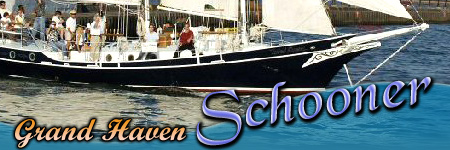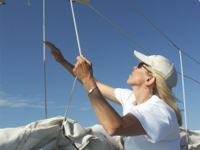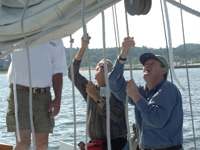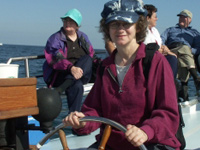
Sail On a Schooner in Grand Haven, Michigan
White
sails billowed above me, the wind whispering over the rippling
canvas like a sea siren calling me to do more-see more-experience
more. An adventure more than ten centuries old beckoned and
I answered the call.
Wind
Dancer Schooner Charters depart out of One South Harbor on
the boardwalk in Grand Haven, Michigan. Captains, Mary and
Chip Sayre, offer more than a boat ride; they provide seafarers
with a chance to participate in all the action. Growing up
land-locked, with next to no boating experience, I'd been
looking forward to the experience for several months before
taking my first voyage.
 |
|
Captain
Mary hoisting the sails |
The
ship was a 61-foot, double gaff-rigged schooner, which told
me little, so I had to satisfy my curiosity with more investigation.
A schooner is a ship with at least 2 masts (foremast and mainmast)
with the mainmast being the taller-which I discovered simply
means it must have two large steel poles to hold the sails,
in land lover's terms. The name, schooner, comes from the
term schoon/scoon, meaning to move smoothly and quickly.
Gaff
rig, I soon learned, is a sailing rig in which the mainsail
is a four-cornered fore-and-aft rigged sail controlled at
its head by a spar called the gaff. A sail hoisted from a
gaff is called a gaff rigged sail, makes sense. I've always
figured hands-on is the best path to knowledge, especially
with this technical stuff, so I joined a few other would-be
sailors learning how to hoist those sails.
Mary
demonstrated what to do, and I volunteered to take a turn.
My grandson, Jon, always made me be the last mate when we
played pirates, so I'd show him when I was done! Bit by bit
the first sail rolled up until it floated in the breeze high
above our heads. It was exhilarating.
My
turn came. Not to be out-sailored, I stood, getting my sea
legs set relatively easily as the schooner glided over the
murky water of Grand River, heading out to Lake Michigan.
I grabbed the rope, feeling its coarse thickness against my
palms. It reminded me of playing tug-of-war, which I hadn't
done since my school days, and I hoped the sail didn't end
up winning out and dragging me over some imaginary finish
line.
 |
In training: learning to hoist sails |
There was no chance of that happening. Instead, I yanked on the rope, drawing on all of my reserves just to see the sail move a few inches higher. No wonder Popeye sported all those muscles! I longed for a can of spinach myself to see if there really was some magic in it. I grew more determined, increasing my efforts to the max. If Jon could have been there to watch me he'd have made me walk the plank for not pulling my weight on the crew-luckily he wasn't. I relinquished the lines to the next participant and dropped into a nearby seat, panting.
The first ships to sail the seas were those of the Ancient Egyptians, who used sails on their Nile barges and reed boats around 2000 BC. They were followed by the Phoenicians, Greeks, and Romans, on their Galley ships. In those days, however, seamen quickly traded in their sails for oars when under attack, since they not only made the ship easier to control, but also faster.
Long ships, their sails filled with ocean breezes, paved the way for the discovery of the Americas. They were the first true sailing ship, because long ship sails were used for power most of the time, instead of relying on an ever-ready bevy of muscled oarsmen. Historians believe the Vikings crossed the ocean using just windpower and sails around 900 AD, leaving their mark in all the villages they raided and pillaged along the way.
Sailboats are steered by means of a rudder, which is a fin or blade attached under the hull's stern-that one made sense, since I'd already learned how to use a paddle to steer a rubber raft being hurled downstream through whitewater rapids. Lessons learned under duress do seem to stick with me for much longer than those that come easy. The next big jump in sailing technology came with the invention of a hinged rudder that improved control capabilities.
Indeed, the next step in my experiences of crewing a schooner was steering, and I had a whole passel of new terms to learn. The schooner, like a car, uses a steering wheel, known in seamen's terms as simply the "wheel." When you take the wheel, however, you take the "helm," which is the whole steering apparatus.
So I dropped into position at the helm of the boat and peered out across Lake Michigan towards the lighthouse Captain Chip indicated on shore. It was to be my point of reference since there were no stars to steer by. My turn as helmsman had begun.
 |
Linda Aksomitis steering the schooner during her adventure |
The port side is the left side of the ship, when you are facing forward as I was, seated at the helm. The simple rule the captain gave for remembering was: Left has four letters, and port has four letters. The right side of the ship is the starboard side, which is, of course the other direction. I preferred to think of it as "I have left the port," which made a lot more sense than I have starboard the port. So, I had mastered the first skill of a helmsman-maybe.
I turned the wheel. Not much happened. Dead ahead was nothing, when it should have been the lighthouse. We were floating on a nice even keel, with the incredible clear blue water of Lake Michigan beneath us, but we were definitely drifting off course. I turned the wheel a lot! Captain Chip explained that less is definitely more, as the schooner headed right by the lighthouse to the other side. Hmm. Driving on water was as tricky as driving on ice, which I, as a northern girl, knew a lot about.
It didn't take long to get the feel of the wheel, and I soon had the schooner gliding smoothly over the water in the direction I wanted, while gulls squawked overhead and my lungs filled with the smell of the crystal clear water. The more fun the adventure is though, the faster it seems to end and I was soon standing on the boardwalk in the historic little community of Grand Haven. But, with my newfound knowledge I was determined not to end up as my grandson's "last mate" again-in fact I'd be able to teach him a thing or two about sailing a schooner.
IF YOU GO |
Wind Dancer Schooner Charters
Mary and Chip Sayre
One South Harbor Drive (boat dock location)
Grand Haven, MI 49417
(616) 822-4210
For more information about visiting Grand Haven contact:
One South Harbor Drive
Grand Haven, MI 49417
(616) 842-4910
(800) 303-4097
Online at: www.grandhavenchamber.org
To learn more about schooner sailing terms visit: www.schoonerman.com |
|